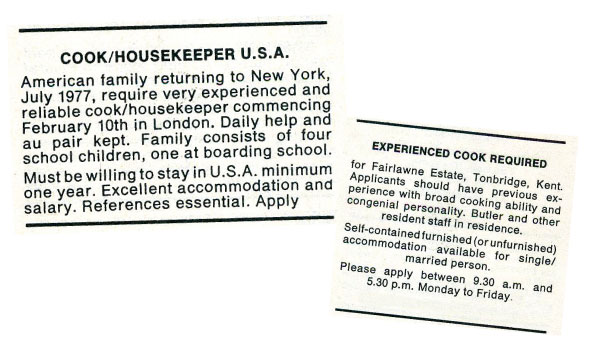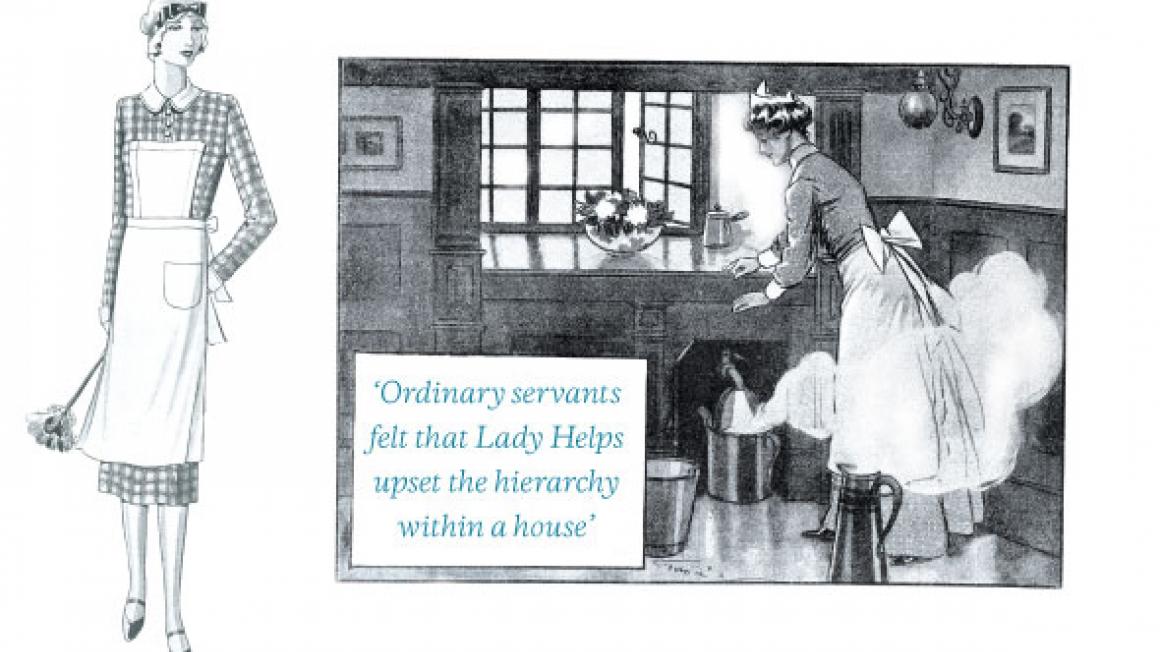Home truths & domestic dramas
The housekeeper sat at the top of the servant hierarchy: a much-caricatured fixture of the big Victorian and Edwardian country house. She was a figure of absolute authority, one who might command up to 100 maids and a domestic budget on a par with a small bank. Think Mrs Hughes of Downton Abbey, but with less cosy chatting and a much greater workload. The housekeeper was also a feature of the aspirational middleclass home – and an affordable luxury at £30 to £45 a year, when an annual income might be around £300.
Her job was to run the home invisibly, taking care of all petty domestic concerns – from scullery maids to store cupboards. She might mend your bed linen, oversee the chimney sweep, pay the butcher – even administer your children’s pocket money. It was an intimate role, and yet it could be a lonely one.
But who were these women who willingly sacrificed running their own home to run another’s? The Lady is where many placed and answered advertisements – and it’s through these Situations Vacant/Wanted columns that I first got a glimpse of the inherent responsibilities and tribulations of the role.
The Lady’s historic classified ads are a fascinating social barometer. Not just for the changing false hairpieces and corset shapes (such as ‘The Dowager’, a corset for ‘the stouter figure prone to flatulence’). They reveal how the power swung gradually away from the upper and uppermiddle classes, with their complacent talk of servants being ‘kept’, to favour those still working in domestic service after two world wars, wooed with increasingly generous promises of private flats, cars, swimming pools – even televisions.
As a ‘journal for gentlewomen’, The Lady had a very particular middle- class readership in the early days, which straddled both those wealthy enough to employ help, and those in straightened circumstances reduced to offering their services. Both sides saw themselves, resolutely, as ‘Ladies’.
Thus, early Situation Vacant ads begin: ‘Can any Lady recommend to me…’, while Situation Wanted ads read: ‘Position sought as Lady Housekeeper, Lady Cook, or Lady Help…’
Genteel appearances had to be maintained at all times, if one was to hold on to one’s fragile dignity.
WHO WAS A LADY HELP?
But what was a ‘Lady Help’ – and how did her various guises as ‘Lady Housekeeper’ or ‘Lady Cook’ diff er from plain old housekeeper or cook? The trend fi rst arose in response to the ‘servant problem’ of the High Victorian era – the increasing absence of young girls willing to go into service, when new work in shops and factories off ered greater freedom and higher wages.She was a gentlewoman who had fallen on hard times: usually widowed, often unmarried, occasionally orphaned. She was reduced to living in another’s house as a thinly disguised common servant. She was, in all likelihood, desperate. Indeed, many advertisements tell a poignant story. These are from 1896, when every woman’s goal was to be mistress of her own home: ‘Lady (young), good social position, experienced traveller, musician, off ers services as Companion, Lady Housekeeper, or Secretary’; ‘Gentlewoman requires, at once, post as Companion, Lady Housekeeper, or any place of trust. Experienced and domesticated. Excellent references.’

Other, more ordinary servants spoke feelingly about how Lady Helps upset a hierarchy within a house. She might typically aff ect airs and graces, refusing to roll up her sleeves and perform tasks herself. She might demand to dine separately, or superior quarters. She was of similar social standing to those she served, yet she was always on the back foot, eating humble pie. Was she, or wasn’t she, a servant?
If the Lady Help drew no salary, and many didn’t, her position was yet more ambiguous. Here is an advert from 1909: ‘Lady desires position as Housekeeper or Companion. Comfortable home more essential than salary. Highest references.’
The ambiguity of the role made it ripe for exploitation. The middle classes were notoriously thrifty, and one can tell much from their advertisements. Clothes were cannily recycled and sold on through The Lady’s Private Exchange And Sale column: ‘Black and sky beauty corsets, with appliance for lengthening the waist, never worn. Cost 19s 6d; for 10s 6d’ (from 1889).
They would get by on two or three servants in a family home if they could – or fewer. ‘Maid kept’ meant that the Lady Help wouldn’t have to ‘do the rough’: the heavy cleaning. More than one ‘Lady’ working in a house – perhaps cook, housekeeper and companion – usually meant canny employers and a hotbed of internal politics.
Alarm bells might ring for this 1892 advertisement: ‘Wanted, a lady as cook, single-handed, where four Lady Helps are kept. Age over 30. Linden Gardens, Bayswater.’ Or this, from 1912: ‘Wanted, two Ladies as Housemaid and House-Parlourmaid. Sisters or friends preferred. Lady cook and lady nurse kept.’
‘Sisters or friends’ was shorthand for sharing a room – or a bed.
A SOCIAL SHIFT
Employing a Lady Help was a way of getting everything done for a low fee, by someone not in a position to refuse the off er of a comfortable home. The balance, in this pre-war era, was most defi nitely stacked against the help.But then came the First World War and everything changed. The big country houses lost their men-servants, while maids vanished from middle-class homes to join the war effort. Advertisements for ‘Lady Grooms’ and ‘Kennel Maids’ proliferated as the upper classes turned to The Lady to staff their mansions: ‘Wanted, in country house, large gardens, home farm in hand, certificated Lady Cook, Lady Head Gardener, under-Gardener, Kennel-Maid for bloodhounds, lady experienced in breaking horses, stable work, farm stock’ (from 1916).
PERKS OF THE JOB
At the same time, thousands of widowed women were forced to find alternative futures in other people’s homes. These strained, upbeat advertisements are almost unbearably poignant. ‘Officer’s widow desires post, Companion, or Lady Housekeeper. Pianist. Good accompanist. Cheerful, amiable’ (1915). Or 1918: ‘Widow lady, 38, desires post as Working Housekeeper in small family, where she can have daughter, aged 13, with her. Help for rough work.’Despite the ‘surplus women problem’ – two million remained unmarried after the First World War – service was unpopular; a last resort for many. Mistresses seeking help were now forced to see the role from the servants’ point of view. Perks of the job began to be listed, such as ‘gas fires’, ‘liberal outings’ and ‘labour-saving appliances’ (these from 1920). By the 1930s, employers were forced to try even harder: ‘Easy, remunerative post for a Lady Cook for Gentlefolk.’
The Second World War saw the tone of The Lady’s small ads change again. Households were being thoroughly shaken up. ‘Lady-Cook-General wanted by officer’s wife, with two paying guests. Lovely country house, Sussex. Meals with Lady-Kennel- Maid.’ Or: ‘Middle-aged lady, homeless, requires post as Companion with light duties. Salary immaterial, but comfortable home, where maid kept.’ Or: ‘Lady (German refugee) requires position of trust in gentleman’s household, where maid kept. Experienced driver. Continental cooking etc.’

After the Second World War, the Wanted jobs column shrank to one page, while the Vacant ads placed by mistresses ran to three. Domestic service as the middle classes had known it was changing again. No longer was it normal to have a housekeeper, or to have a live-in maid.
Women who had never had to turn their hands to domestic duties were left high and dry. Indeed, their Situations Vacant advertisements began to strike a note of faint hysteria: ‘Companion- housekeeper-cook to share comforts and work of delightful modern house, two in family.’
‘Excellent accommodation and generous salary and outings’ reads another from 1948; ‘own sitting room, second bathroom, electricity, bus route and stop at gate.’
No longer the poor relation with the brave smile, the Lady Help now seemed to hold all the cards. By 1964 she could even be a single parent – ‘Own child not necessarily a disadvantage’ – and she expected her own quarters: ‘Self-contained accommodation with all modern conveniences,’ perhaps with ‘own TV and radio.’
‘Generous free time’ was, by now, a given. And there is something else in these small ads from the 1960s: ‘Applicant’s private life respected.’ These are new words.
As is this, from the 1970s: ‘Lady, 41, divorced with two well-behaved sons age 13 and 7. Seeks position with accommodation or live in, as cook-housekeeper. Loves cooking, gardening, decorating.’
Domestic employment is thriving again, but The Lady’s historic small ads tell fascinating stories. Each one has a voice, a pressing need, a particular situation. Those who placed them were often putting on a brave face to the world – and this can include both servant and mistress. It is as well to remember that fate can be kind to a lady, but it can also turn on a sixpence.
The Housekeeper’s Tale: The Women Who Really Ran The English Country House, by Tessa Boase, is published by Aurum Press, priced £20.
Looking for a job or a perfect member of staff? Turn to our essential small ads in the Classifieds section.


